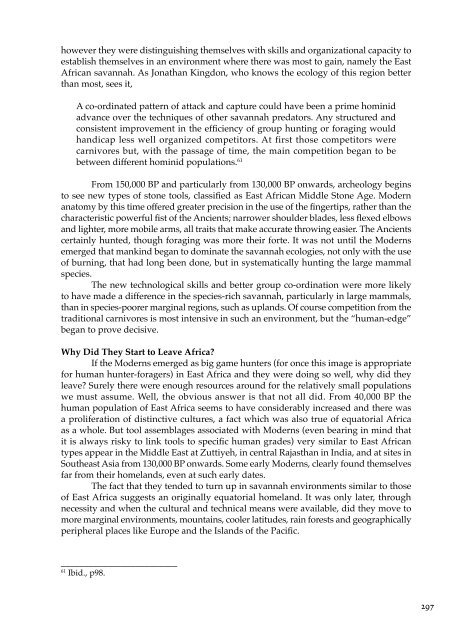The Spirit in Human Evolution - Waldorf Research Institute
The Spirit in Human Evolution - Waldorf Research Institute
The Spirit in Human Evolution - Waldorf Research Institute
Create successful ePaper yourself
Turn your PDF publications into a flip-book with our unique Google optimized e-Paper software.
however they were dist<strong>in</strong>guish<strong>in</strong>g themselves with skills and organizational capacity to<br />
establish themselves <strong>in</strong> an environment where there was most to ga<strong>in</strong>, namely the East<br />
African savannah. As Jonathan K<strong>in</strong>gdon, who knows the ecology of this region better<br />
than most, sees it,<br />
A co-ord<strong>in</strong>ated pattern of attack and capture could have been a prime hom<strong>in</strong>id<br />
advance over the techniques of other savannah predators. Any structured and<br />
consistent improvement <strong>in</strong> the efficiency of group hunt<strong>in</strong>g or forag<strong>in</strong>g would<br />
handicap less well organized competitors. At first those competitors were<br />
carnivores but, with the passage of time, the ma<strong>in</strong> competition began to be<br />
between different hom<strong>in</strong>id populations. 61<br />
From 150,000 BP and particularly from 130,000 BP onwards, archeology beg<strong>in</strong>s<br />
to see new types of stone tools, classified as East African Middle Stone Age. Modern<br />
anatomy by this time offered greater precision <strong>in</strong> the use of the f<strong>in</strong>gertips, rather than the<br />
characteristic powerful fist of the Ancients; narrower shoulder blades, less flexed elbows<br />
and lighter, more mobile arms, all traits that make accurate throw<strong>in</strong>g easier. <strong>The</strong> Ancients<br />
certa<strong>in</strong>ly hunted, though forag<strong>in</strong>g was more their forte. It was not until the Moderns<br />
emerged that mank<strong>in</strong>d began to dom<strong>in</strong>ate the savannah ecologies, not only with the use<br />
of burn<strong>in</strong>g, that had long been done, but <strong>in</strong> systematically hunt<strong>in</strong>g the large mammal<br />
species.<br />
<strong>The</strong> new technological skills and better group co-ord<strong>in</strong>ation were more likely<br />
to have made a difference <strong>in</strong> the species-rich savannah, particularly <strong>in</strong> large mammals,<br />
than <strong>in</strong> species-poorer marg<strong>in</strong>al regions, such as uplands. Of course competition from the<br />
traditional carnivores is most <strong>in</strong>tensive <strong>in</strong> such an environment, but the “human-edge”<br />
began to prove decisive.<br />
Why Did <strong>The</strong>y Start to Leave Africa?<br />
If the Moderns emerged as big game hunters (for once this image is appropriate<br />
for human hunter-foragers) <strong>in</strong> East Africa and they were do<strong>in</strong>g so well, why did they<br />
leave? Surely there were enough resources around for the relatively small populations<br />
we must assume. Well, the obvious answer is that not all did. From 40,000 BP the<br />
human population of East Africa seems to have considerably <strong>in</strong>creased and there was<br />
a proliferation of dist<strong>in</strong>ctive cultures, a fact which was also true of equatorial Africa<br />
as a whole. But tool assemblages associated with Moderns (even bear<strong>in</strong>g <strong>in</strong> m<strong>in</strong>d that<br />
it is always risky to l<strong>in</strong>k tools to specific human grades) very similar to East African<br />
types appear <strong>in</strong> the Middle East at Zuttiyeh, <strong>in</strong> central Rajasthan <strong>in</strong> India, and at sites <strong>in</strong><br />
Southeast Asia from 130,000 BP onwards. Some early Moderns, clearly found themselves<br />
far from their homelands, even at such early dates.<br />
<strong>The</strong> fact that they tended to turn up <strong>in</strong> savannah environments similar to those<br />
of East Africa suggests an orig<strong>in</strong>ally equatorial homeland. It was only later, through<br />
necessity and when the cultural and technical means were available, did they move to<br />
more marg<strong>in</strong>al environments, mounta<strong>in</strong>s, cooler latitudes, ra<strong>in</strong> forests and geographically<br />
peripheral places like Europe and the Islands of the Pacific.<br />
_________________________<br />
61<br />
Ibid., p98.<br />
297
















